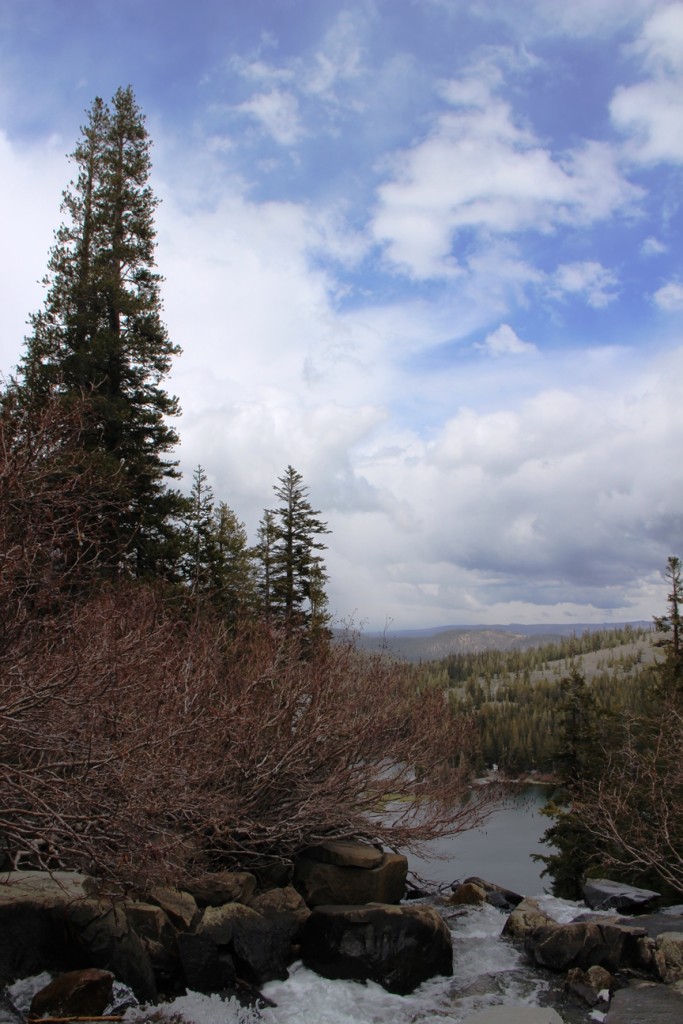Mammoth Lakes, located in California’s Eastern Sierra Nevada Mountains, is a mecca of recreational activity. Best known as a winter ski resort, warmer weather attracts mountain bikers, campers, equestrians, backpackers and many other summer sport enthusiasts. We happened to visit in May when only a few skiers were taking advantage of what snow was left in the mountains. Summer attractions hadn’t opened for the season yet, and several of the area restaurants were closed. However, despite visiting in the off season, we found plenty to fill our time.
Editor’s Note: This article originally appeared in U.S. Long Cuts. We are merging U.S. Long Cuts with Midwest Wanderer, adding a “Beyond the Midwest” menu option.
Mammoth Lakes Basin
We spent the better part of a day exploring the Mammoth Lakes Basin, just outside of Mammoth Lakes in the Inyo National Forest, which surrounds the town. Massive glaciers moved through the area during the Ice Age, carving the basin and creating several lakes. Lake Mary Road leads to several of these lakes, and you can hike to others. Since the day was chilly—and of course, the higher we climbed into the mountains, the colder it got—we stayed on the road, getting out for just short walks and to take photographs.
 Along the drive, we noticed several die-hard anglers, bundled up against the cold mountain air, standing at the edge of lakes or sitting in folding chairs, fishing lines cast into the water.
Along the drive, we noticed several die-hard anglers, bundled up against the cold mountain air, standing at the edge of lakes or sitting in folding chairs, fishing lines cast into the water.

 During one of our walks, we found some odd shaped trees, including one that looked like a woman bent over and another with a big pot belly.
During one of our walks, we found some odd shaped trees, including one that looked like a woman bent over and another with a big pot belly.

 But mostly we admired the beautiful work of nature, the blue sky peeking out only occasionally throughout the day.
But mostly we admired the beautiful work of nature, the blue sky peeking out only occasionally throughout the day.


 When we got to Horseshoe Lake we saw a lot of dead trees. A sign explained that after a series of earthquakes in 1989, a high level of carbon dioxide was found in the area. Although trees take in carbon dioxide and emit oxygen, their roots absorb oxygen from the earth. The high level of carbon dioxide beneath the earth’s surface cut off the oxygen supply from the tree roots, causing the trees to die.
When we got to Horseshoe Lake we saw a lot of dead trees. A sign explained that after a series of earthquakes in 1989, a high level of carbon dioxide was found in the area. Although trees take in carbon dioxide and emit oxygen, their roots absorb oxygen from the earth. The high level of carbon dioxide beneath the earth’s surface cut off the oxygen supply from the tree roots, causing the trees to die.
 We started our descent back down the road just as snowflakes began to fly. We’d find out the next day that the road we planned to take on the next leg of our trip, through Yosemite National Park, was closed because of the snow, but for the time being, we had more of the Mammoth Lakes area to explore.
We started our descent back down the road just as snowflakes began to fly. We’d find out the next day that the road we planned to take on the next leg of our trip, through Yosemite National Park, was closed because of the snow, but for the time being, we had more of the Mammoth Lakes area to explore.
Don’t miss a Midwest Wanderer post. For a FREE subscription, enter your e-mail address in the Subscribe2 box to the right and click Subscribe.
Earthquake Fault
We couldn’t resist following the signs to the Earthquake Fault and were glad it wasn’t one of the roads still closed for the season. What we saw is actually a fissure, a crack in the earth that ranges from six to ten feet wide. The fissure is a result of volcanic activity 550 to 600 years ago, when molten rock pushed its way toward the earth’s surface. We walked a path partway around the crack, crossing back over a bridge from where we got a great view of this phenomenon.

 Even though not everything was open during our off-season visit, we also had the advantage of it not being crowded. We never experienced a traffic jam or had trouble finding a parking space. There are definite advantages to visiting a ski resort in the off season.
Even though not everything was open during our off-season visit, we also had the advantage of it not being crowded. We never experienced a traffic jam or had trouble finding a parking space. There are definite advantages to visiting a ski resort in the off season.
To learn more about the Mammoth Lakes area, including things to do in all four seasons, visit the Mammoth Lakes web site.
Accommodations in the Mammoth Lakes area
We stayed at the Sierra Nevada Resort & Spa. Find the best hotel deal, compare prices, and read what other travelers have to say at TripAdvisor.
**********
Disclosures: Our stay at the Sierra Nevada Resort & Spa was hosted by the Mammoth Lakes Tourism and the hotel.
This articles contains an affiliate link, which means that if you book a room through the TripAdvisor link above, I will receive a small commission, at no additional cost to you.
Thank you for reading Midwest Wanderer. Don’t miss a post. Enter your e-mail address below and click Subscribe to be notified whenever I publish another post. Subscription is FREE. After subscribing, be sure to click the link when you get the e-mail asking you to confirm. – Connie
